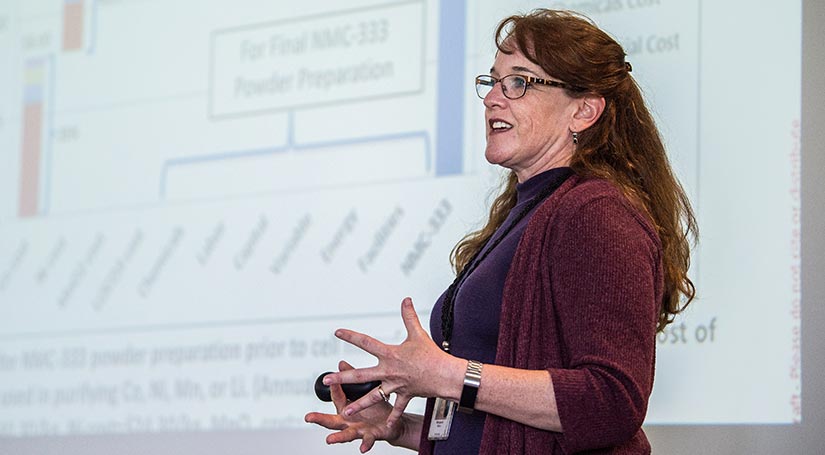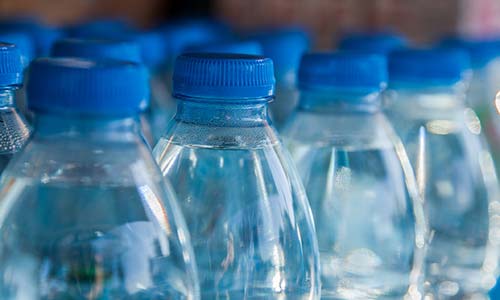Modeling a Future for Sustainable Energy Storage

Maggie Mann, NREL manager of the Mobility Infrastructure and Impacts Analysis group.
As manager of the Mobility Infrastructure and Impacts Analysis group, the National Renewable Energy Laboratory's (NREL's) Maggie Mann will be the first to tell you that electric vehicles (EVs) alone are not a perfect solution to achieve sustainability within the transportation industry.
The lithium-ion (Li-ion) batteries used in EVs depend on numerous materials, many of which suffer from limited supply, potential supply-chain bottlenecks, and environmental concerns. However, by focusing on resource sustainability and circularity where Li-ion batteries can be repurposed, remanufactured, and recycled, NREL researchers can support a clean energy transition for a decarbonized and resilient U.S. energy economy.
Maggie's analysis work at NREL leads the charge toward a circular economy for Li-ion batteries by identifying a path forward for viable recycling.
What is your primary research focus at NREL?
Throughout my time at NREL, my analysis work has spanned various research arenas. Today I work in the rapidly evolving mobility and transportation area. Much of my work focuses on the implementation of sustainable energy storage technologies.
For several years, NREL has been studying the materials supply chain for manufacturing Li-ion batteries for EVs, focusing on resource availability and cost. This work supports President Biden's executive order encouraging domestic battery manufacturing and requiring a related supply chain review. A recent New York Times article in which I was quoted touched on the topic. This analysis looked at the global flow of cobalt, nickel, and lithium through the trade of raw materials, chemical intermediates, manufactured components, finished products, and recycling.
The NREL-developed Lithium-Ion Battery Resource Assessment (LIBRA) model evaluates the economic viability of Li-ion battery manufacturing, reuse, and recycling industries, highlighting global and regional impacts across interlinking supply chains. LIBRA allows researchers to assess the evolution of the battery markets from both supply and demand perspectives, characterizing the entire circular economy for Li-ion batteries.
In your field of research, what one challenge do we need to prioritize in the next five years?
It's critical that we prioritize mindful decarbonization by pursuing strategies and infrastructure build-out in an efficient and cost-effective way while ensuring the solutions benefit everyone.
What sparked your interest in researching sustainable technologies?
I've always been an early adopter of sustainable technologies. I have photovoltaics on my roof and have subscribed to Xcel's Windsource program since its inception. I have also replaced and installed windows myself, heated my house with biomass for a while, and bought a Prius way back in 2003. Since then, I upgraded, first to a plug-in hybrid, and later an all-electric vehicle. It has been a fantastic car, and I doubt I will ever go back to a conventional gasoline vehicle.
Since analysis is my forte, I love being able to integrate my personal experiences with sustainable technologies into the studies I conduct and lead at NREL. I feel so blessed to work at NREL during this time of pivotal change as we transition to a decarbonized future.
Why does sustainable energy storage matter?
More than just ensuring a sustainable future for spent and discarded Li-ion batteries, building a circular economy for battery materials is essential to the decarbonization of the U.S. economy. Clean energy generation technologies, such as wind or solar, will increasingly rely on energy storage solutions like Li-ion batteries. However, the materials used to manufacture these batteries, such as cobalt, are difficult to obtain. By recycling Li-ion batteries and developing alternatives with lower amounts of critical materials that are more sustainably sourced, the U.S. can mitigate resource constraints that challenge future battery manufacturing and the decarbonization of the transportation sector.
Our analysis activities provide options and vital data for decision-makers, revealing what programs and policies will have the most significant impact as we accelerate toward sustainable energy storage.
Learn more about energy storage, transportation and mobility, and analysis research at NREL.
This article has been updated to reflect an editorial change made after its original publication.
Last Updated May 28, 2025

